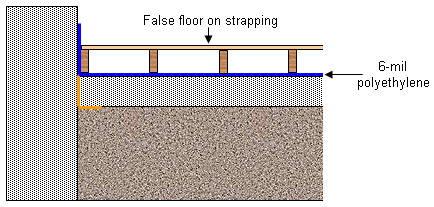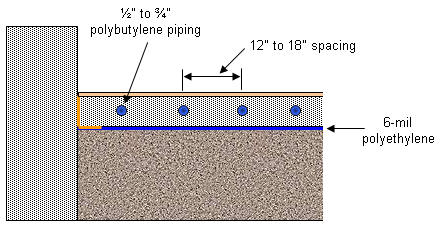Slabs-On-Ground - Water Leakage
Problem: Damp or wet floor slab.
Cause: Moisture migration up through the slab.
Solutions: Provide a capillary break and appropriate resistance to moisture diffusion.
- Ensure flood site drainage away from the slab.
- Provide a minimum of 4 inches (100 mm) of coarse, clean, granular fill below the slab-on-ground. This base will restrict capillary wicking of soil moisture and allow for depressurization below the slab to remove soil gases in areas where they might pose a problem.
- Provide a moisture barrier under the floor slabs to prevent moisture movement through the slabs. Polyethylene 6-mil (0.15 mm) is commonly used.
Problem: Cold Floors.
Cause: Heat loss from the slab.
To maintain appropriate soil temperatures below the slab, heat flow through the slabs-on-ground is required. Increasing the amount of perimeter insulation will increase soil temperatures below the slab thus reducing heat loss. Caution. A minor difference between the temperature of the slab and that of the human body will be noticeable, so the more this difference is reduced, the better.
Solutions: Minimize direct contact with the slab, or warm the slab.
- Install carpeting or a false floor to minimize contact with the cooler surface temperature of the slab as shown in Figure 41.

Figure 41 - False Floor
Provide radiant heating of the slab. This will improve comport, but the higher rates of heat loss to the surrounding soils will increase heating costs. Typically in radiant heating, hot water is circulated in 1/2 to 3/4 inch polybutylene piping spaced at 12 to 18 inches under, or embedded in) the slab as shown in Figure 42.
Additional information on electric radiant heating and hydronic radiant heating.

